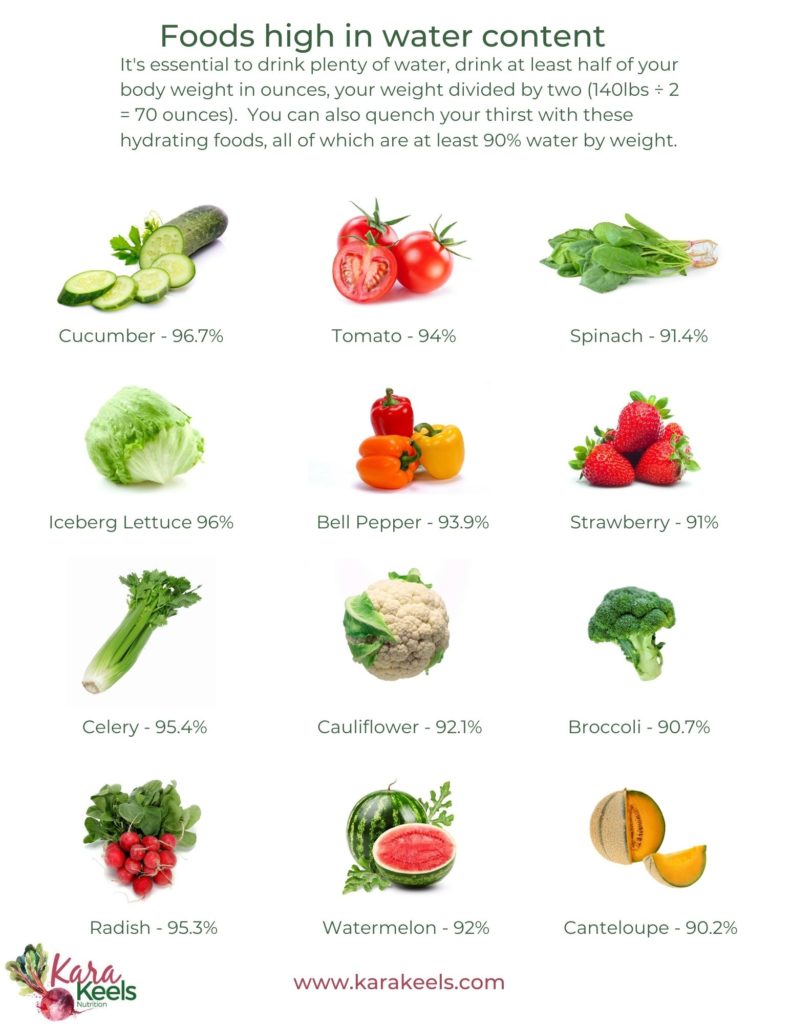Seasonal produce can help you stay hydrated. I’m back to talk about hydration and electrolytes. Many of you reached out to me about this topic, so I am responding.
You can read my first hydration newsletter here Hydration Foundation
As I have said in the past, it’s essential to drink plenty of water, drink at least half of your body weight in ounces; your weight divided by two (140lbs ÷ 2 = 70 ounces). Water is the most vital nutrient in your body.
You can also quench your thirst with these hydrating foods, all of which are at least 90% water by weight and have minerals that will help with balancing your electrolytes. While many foods provide water content and electrolytes, today, we are focusing on summer produce.
Cucumber water content: 96.7%
Cucumbers have the highest water content of any solid food. Cucumbers are a good source of potassium. They are perfect in salads or sliced up and served with hummus or guacamole.
Iceberg Lettuce water content: 96%
Iceberg lettuce tends to get a bad rap, nutrition-wise. Many health experts recommend shunning it in favor of darker greens like spinach or romaine lettuce, which contain higher amounts of fiber and nutrients such as folate and vitamin K. It’s a different story when it comes to water content, though: Crispy iceberg has the highest of any lettuce, followed by butterhead, green leaf, and romaine varieties. If you find yourself iceberg adverse, try mixing it in with the darker greens, and you will find that it makes a perfect combination.
Celery water content: 95.4%
Celery provides several of the essential electrolytes; sodium, potassium, magnesium, chloride, and phosphorus. It’s not only a great snack for those watching calories; it’s perfect for hydrating and adding fiber to your diet.
Radish water content: 95.3%
These root vegetables are a perfect addition to your summer salads. They provide a burst of spicy-sweet flavor and color. Radishes are a great source of potassium, as well as antioxidants such as catechin (also found in green tea). I love the more peppery radish and grow those in my garden.
Tomato water content: 94%
Tomatoes are my all-time favorite, they are highly nutritious, and they can help the body stay hydrated. Tomatoes are packed with chloride, an electrolyte that works with sodium to maintain fluid balance. Peeling the fibrous skin will help boost the tomato’s hydrating powers, but I like the skin.
Bell Pepper water content: 93.9%
Bell peppers of all shades have a high water content, but green peppers lead the pack, just edging out the red and yellow varieties (which are about 92% water). Bell peppers are also full of minerals such as iron, copper, zinc, potassium, manganese, magnesium, and selenium. The high levels of vitamin A and C in peppers is also worth mentioning. Peppers are a great pre-dinner or late-night snack, and I like to keep them sliced and ready to go at a moment’s notice.
Cauliflower water content: 92.1%
In addition to having a high water content, they contain vitamins, phytonutrients, and potassium. I crave cauliflower, it sounds strange, but it’s better than craving chips!
Watermelon water content: 92%
It’s evident that watermelon is full of water, but it’s is also among the richest sources of lycopene, a cancer-fighting antioxidant found in red fruits and vegetables. Watermelon is also a good source of potassium, pantothenic acid, biotin, magnesium, and dietary fiber. Last year I finally learned how to pick a good watermelon.
Spinach water content: 91.4%
Spinach is rich in lutein, potassium, fiber, and brain-boosting folate, and just one cup of raw leaves contains 15% of your daily intake of vitamin E, an essential antioxidant for fighting off the damaging molecules known as free radicals.
Strawberries water content: 91%
All berries are good for hydration, but strawberries are the best of the bunch. Raspberries and blueberries both hover around 85% water, while blackberries are only slightly better at 88.2%. Strawberries are known for their antioxidant vitamin C content, but they also contain potassium.
Broccoli water content: 90.7%
Raw broccoli adds a satisfying crunch to a salad. Its nutritional profile is impressive. Broccoli contains fiber, potassium, vitamin A, and vitamin C.
Cantaloupe water content: 90.2%
With its high water and electrolyte contents, cantaloupe is an excellent choice for boosting hydration during hot summer months or after a workout. Examples of electrolytes in cantaloupe include sodium, potassium, calcium, and magnesium.
My favorite tip
You can also maintain proper hydration by drinking my favorite mixture of water, lemon, and a pinch Real Salt® from Redmond’s. Drink it first thing in the morning and throughout the day as needed.
I keep a small container of Real Salt® on me at all times. I find it helps with leg and feet cramps. I will put a pinch on my tongue and leave it to dissolve. It is the most instant relief for cramping that I have found.
I hope this helps you with some ideas on how you can replenish your water intake and gain electrolytes while doing so.
Now, get out there and buy some local produce while it’s still in season and enjoy the full benefits of their vitamins and minerals.
Stay hydrated!

